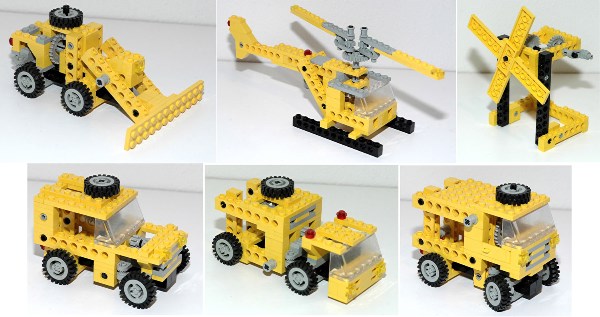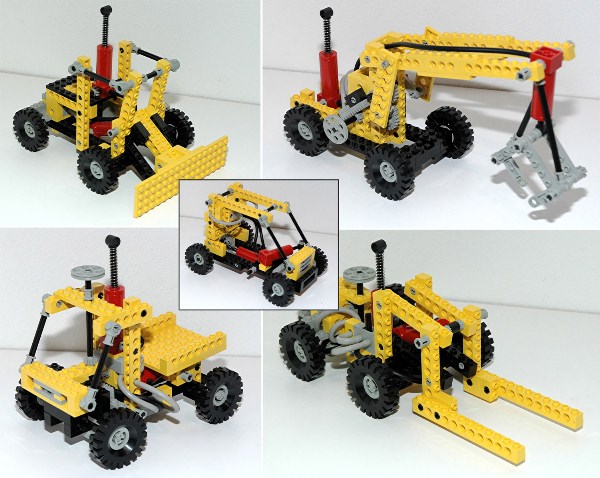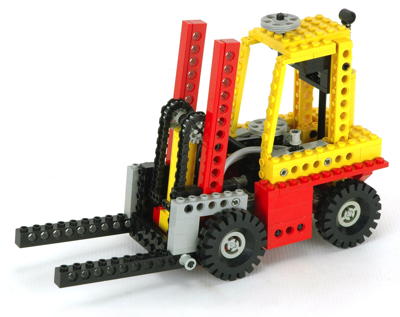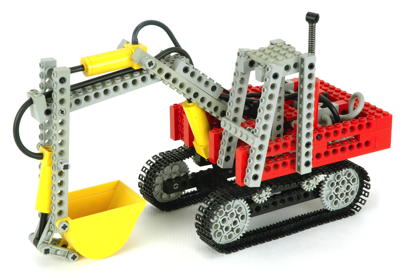Pneumatics
This first generation pneumatics, released this year, are
exciting but were short lived. The single acting system has some
serious limitations which were corrected in the second generation of
pneumatics.
- Actuators: There are two different lengths of linear
pneumatic actuators which differ only in stroke. There is a
single pressure port on the head end side of the cylinder. Using
this port, the actuator can generate both compression (via pressure),
and tension (via suction). The limitation on the compression
force is that the piston head internal to the actuator will begin to
leak after a certain pressure, acting as a pressure relief valve.
The limitation on tension force is that there is no such thing as
suction! Rod end pressure generated by the atmosphere actually
pushes the piston the other way to produce tension, so there can never
be more than atmospheric pressure generating tension. This means
that if you bring your excavator along with you when you summit Mt.
Everest, it won't work very well.
- Pumps: The standard pump is identical to the actuator
except that it has a spring on the rod. There are two pumps which
both use the short cylinder, but differ in using either the long or the
short rod. The one with the short rod has a short stroke because
the spring bottoms out before the piston is fully compressed. The
other can achieve full stroke. One of the limitations here is
that suction is only generated by the force of the return spring unless
you actually pull the rod up.
- Distribution block: This little gem is the magic
behind the single acting system, and in fact the system would not work
without it. It is the size of a 2x4 brick but has 3 pneumatic
ports. The center port is for input from the pump. Each
outboard port contains a check valve so that flow can only occur in one
direction. Both are connected to center. The left port is
for suction, and the right for pressure. Both of these ports are
connected to the switch.
- Switch: The switch is really a pneumatic selector
valve and is the size of two 1x2 bricks. The outer ports are
connected to the two ports of the distribution block. The center
port runs out to one or more actuators. When the switch is at the
center position, all ports are blocked. When the switch is moved
to one position or the other, one of the outer ports and the center
port are connected to the distribution block and the other is vented to
atmosphere.
- T-fitting: This splitter can be placed either between
the distribution block and one or more switches, or downstream of a
switch to allow multiple actuators on a circuit.
Compression Summary: Depression of the pump produces
pressure. Pressure flows to center port of distribution block and
out of right port. Pressure flows to enabled switch and out
center port to actuator, extending it. Return of the pump draws
in air through the switch via the left port of the distribution block.
Tension Summary: Return of the pump produces suction.
Suction flows to center port of distribution block and out of left
port. Pressure flows to enabled switch and out center port to
actuator, retracting it. Depression of the pump blows out air
through the
switch via the right port of the distribution block. (This is all
backwards since suction is really atmospheric pressure, but it works
for illustrative purposes.)
Bucket
A new single purpose bucket was introduced for the excavator which was
only ever used in one other model.
Threaded
Axle
A new threaded axle was introduced. It has the same cruciform
cross section as the regular axle but is also right-hand
threaded. With the addition of the new nut, this axle can now
carry significant tension load instead of just compression and
torque. This allows it to be used to hold unstable structures
together (like the superstructure of the excavator). The nut fits
between 4 studs to lock in position to a plate, and two nuts can be
jammed together to lock them to the axle.
3L
Axle
This is the first year that a 3L axle was available, the first odd
length. No other odd lengths would be available for a long time.
|
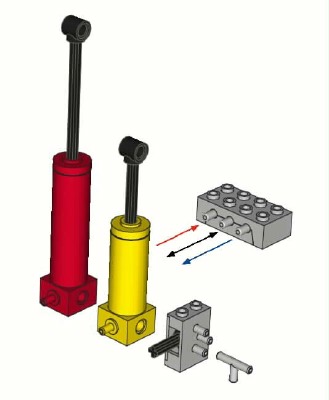
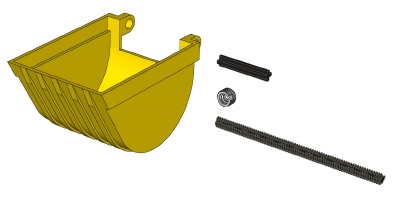
|


